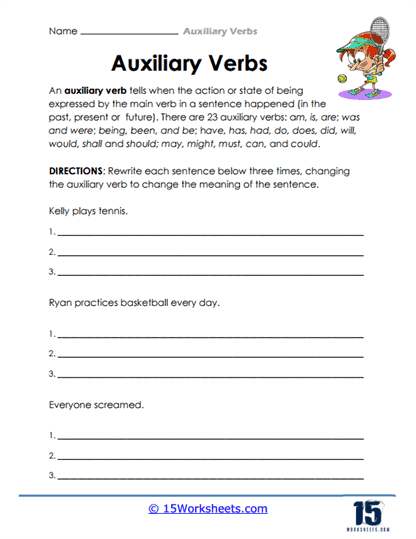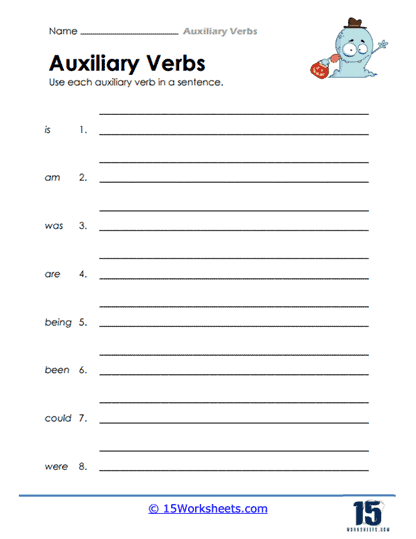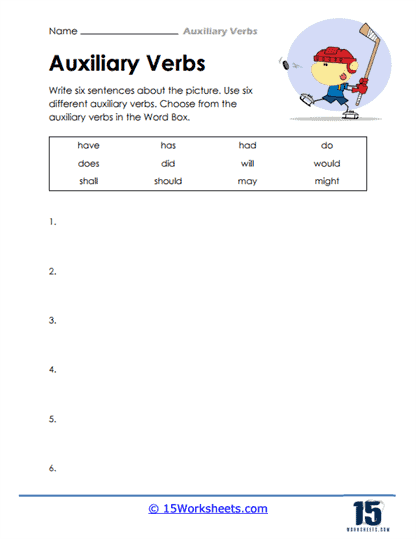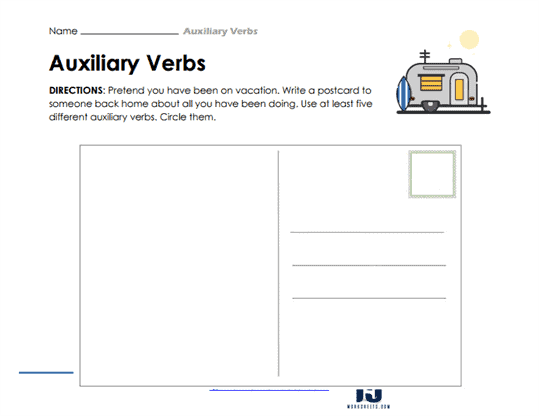Auxiliary Verbs Worksheets
All About These 15 Worksheets
These auxiliary verbs worksheets help students understand the usage and functions of auxiliary verbs in English grammar. Auxiliary verbs, also known as helping verbs, are used in combination with main verbs to express various meanings and tenses.
The worksheets typically begin with an introduction to the definition and functions of auxiliary verbs and main or primary verbs. The worksheets may provide examples of auxiliary verbs used in different contexts and guide students in identifying them in sentences.
They also include exercises where students have to choose the correct auxiliary verb to complete a sentence or distinguish whether the auxiliary verb used in a sentence is correct or incorrect. These exercises will help students to understand how auxiliary verbs can change the meaning of a sentence and how to use them correctly in sentences.
There will also be some activities in these worksheets that encourage students to create their own sentences using auxiliary verbs, which will help them to develop their language skills and express themselves more effectively.
Through answering these worksheets, the students will be able to:
- Complete sentences by supplying the correct auxiliary verb;
- Determine whether the auxiliary verb in a sentence is used correctly or not;
- Correct sentences with incorrect usage of auxiliary verbs;
- Construct their own sentences that use auxiliary verbs correctly;
- Understand how different auxiliary verbs can change the meaning of sentences;
- And be familiar with all forms and placements of auxiliary verbs.
Overall, these worksheets provide students with a clear understanding of what auxiliary verbs are, how to identify them in sentences, and how to use them correctly to enhance their writing.
What are Auxiliary Verbs and why do they matter?
Auxiliary verbs, also known as helping verbs, are verbs used in combination with main verbs to express various meanings and tenses in English grammar.
The primary auxiliary verbs in English are “be,” “do,” and “have.” These verbs can be used alone or in combination with other verbs to form different verb tenses, such as the present tense, past tense, and future tense.
For example, “be” can be used as an auxiliary verb to form the present continuous tense, as in “I am studying,” or the past continuous tense, as in “He was sleeping.” “Do” can be used as an auxiliary verb to form questions and negatives, as in “Do you like pizza?” or “I don’t know.” “Have” can be used as an auxiliary verb to form the present perfect tense, as in “She has eaten breakfast.”
Modal auxiliary verbs are another type of auxiliary verb in English. They include “can,” “could,” “may,” “might,” “shall,” “should,” “will,” “would,” and “must.” These verbs are used to indicate possibility, ability, permission, obligation, or likelihood.
For example, “can” can be used to express ability, as in “I can swim,” or permission, as in “Can I leave early?” “Must” can be used to express obligation, as in “I must finish my homework.”
Auxiliary verbs are important in English grammar because they are used to form verb tenses and to indicate various meanings and functions. Understanding the usage and functions of auxiliary verbs is essential for effective communication and writing.















